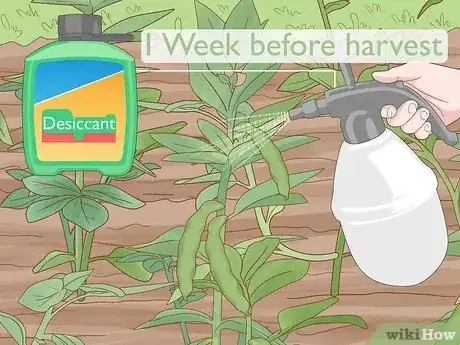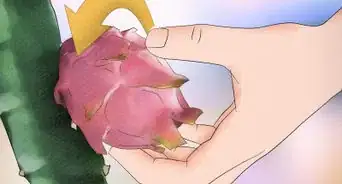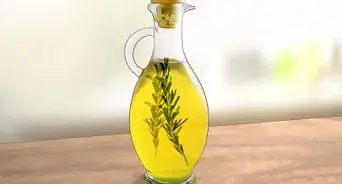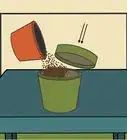This article was co-authored by Lauren Kurtz. Lauren Kurtz is a Naturalist and Horticultural Specialist. Lauren has worked for Aurora, Colorado managing the Water-Wise Garden at Aurora Municipal Center for the Water Conservation Department. She earned a BA in Environmental and Sustainability Studies from Western Michigan University in 2014.
There are 7 references cited in this article, which can be found at the bottom of the page.
This article has been viewed 36,984 times.
Lentils are quickly becoming a favorite crop due to their amazing health benefits and versatility in cooking. Lentils are usually grown on large farms and harvested using expensive equipment. If you've grown lentils at home, however, you can harvest your lentils with a few basic tools found around your house. Just remember that lentils must be dried on the plant to be harvested. If your plants aren't drying fast enough, you can try to speed up the process with a few tricks.
Steps
Checking for Plant Maturity
-
1Wait until July or August to harvest. Dried lentils should be harvested around 110 days after sowing. In most areas, this will be in July or August. Make sure that the weather is dry when you start to harvest.[1]
- If you harvest the lentils during rainy or wet weather, they may not dry out properly.
-
2Shake the plants to hear if they rattle. Lightly grasp the top of the plant before shaking it. If it is ready to harvest, you should hear the pods rattling. This rattle means that the pods on the bottom of the plant are mature and dried.Advertisement
-
3Inspect the bottom of the plants for brown and yellow pods. Lentils mature from the bottom of the plant up. While the top pods may not be mature yet, you should look at the bottom for hard, dry brown or yellow pods. This means that you can start to harvest the plants.[2]
- Don't try to wait for the top pods to mature if the bottom pods are ready. Most of your harvest will come from the lower pods. If you wait too long, they may shatter.[3]
Harvesting and Drying the Lentils
-
1Apply desiccant about 1 week before harvest to speed up drying. Since plants can dry unevenly, spraying a chemical desiccant onto the plants can help them reach the right moisture level at the same time. Some common desiccants include glyphosate, glufosinate, and diquat.[4]
- Different products may vary in how long they take to desiccate the plant. Always read the label see how long you need to give the plants, and follow all instructions as you use the product.
- Check in advance to ensure that the product you purchased is safe to use on foods.
- While this can help dry out pods, it will not make immature pods ripen faster. It will help speed up the drying process, however, if you live in an area with a short growing season.
-
2Pull the lentil plants from the ground when they are ready to harvest. Once mature and dry, lentil plants should be easy to pull up from the ground. Grasp the plant as close to the ground as possible before lifting up. Set the plants aside in a pile until you have removed them all.
- It is a good idea to wear gardening gloves as you do this to protect your hands.
-
3Lay the harvested plants to dry in the sun for an organic approach. Once the plants have been pulled from the ground, spread them out in a straight line outdoors. The weather must be sunny and dry without any wind for this to work. After a week, the plants will turn brown, making it easy to harvest the lentils from the plants.
- This works well if you want to speed up the drying process without the use of chemical desiccants. It does require the right type of weather, however.
-
4Dry lentils indoors if the weather is too wet or cloudy. Choose a shed, garage, or room with good ventilation. Hang the stems upside down on a drying rack. After 1-2 weeks, the plants may turn brown and dry.[5]
- This is also a good idea if the weather is very windy. Wind can damage lentil plants that have been pulled up from the ground.
- If you have picked your plants but have noticed that some are still unripe, you can let them ripen and dry out using this same method. Leave them to dry until the pods turn brown or yellow and rattle when shaken.
Separating the Lentils from the Plants
-
1Thresh the lentils to shake them loose from the plant. There are many ways you can thresh the lentils. You can start with small stems and rub the plants between your hands until the lentils fall off. Or you can put the lentils in a bag or pillowcase. Hit the bag with a stick or walk on top of the bag to free the lentils.[6]
- Threshing can also help shell the lentils, breaking them away from their pods.
-
2Remove pods by hand if any remain after threshing. You can also remove the lentils by hand. If they are mature, they should come off easily when you pull them from the plant. Since this can be time consuming, only do this for lentils that did not come off from shaking the plant.[7]
- Try rubbing off any remaining pods. Put the stem in the palm of your hand and use your fingers to separate the lentils.
- If the lentils don't fall off easily, they may not be ripe enough. Try leaving them on a drying rack for a few days.
-
3Winnow the lentils to remove the chaff and other debris. Get 2 buckets that can hold your harvest. Stand outside and pour the lentils into 1 bucket. Lift up the bucket and pour the lentils into the second bucket. Keep pouring the lentils between the buckets until most of the chaff blows away.
- When you pour the lentils into the bucket, chaff blows away in the wind while the heavier lentils remain in the buckets.
- If you can't go outside, stand in front of a fan on a low setting.
- Chaff includes leaves, stems, and other bits of dirt that might become mixed in with the lentils. It can also include shattered seed bits.
-
4Store the lentils in a dry, cool place. Keep dried lentils in a jar or plastic container, preferably one that is airtight. Put the container in a pantry, cabinet, or another dry place. Dried lentils will last for about 10-12 months if stored properly.[8]
- It can be difficult to tell when lentils have gone bad. If they appear hard and brittle or if they take longer to cook than normal, you may wish to toss them.
Things You'll Need
- Gardening gloves
- Airtight jar or container
- Chemical desiccant
- Drying rack
- Bag or pillowcase
- Buckets
References
- ↑ https://harvesttotable.com/how_to_grow_lentil/
- ↑ https://albertapulse.com/lentil-harvesting/
- ↑ https://www.grainews.ca/2016/06/22/consider-timing-when-choosing-desiccants-for-lentils/
- ↑ https://albertapulse.com/lentil-harvesting/
- ↑ https://www.nature-and-garden.com/gardening/lentil.html
- ↑ https://www.crops.org/files/story/grow-pulses.pdf
- ↑ https://www.crops.org/files/story/grow-pulses.pdf
- ↑ https://harvesttotable.com/how_to_grow_lentil/
- ↑ https://www.nature-and-garden.com/gardening/lentil.html






































































